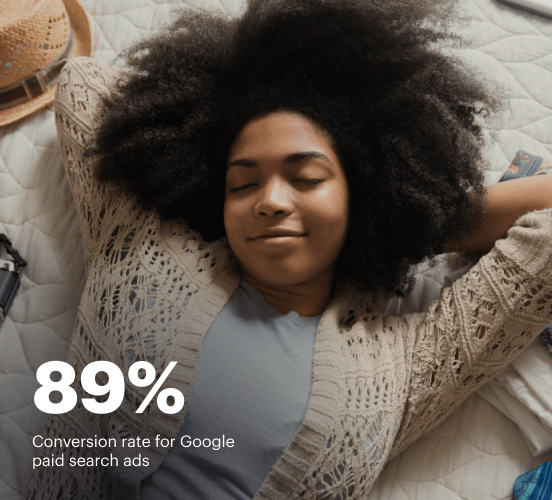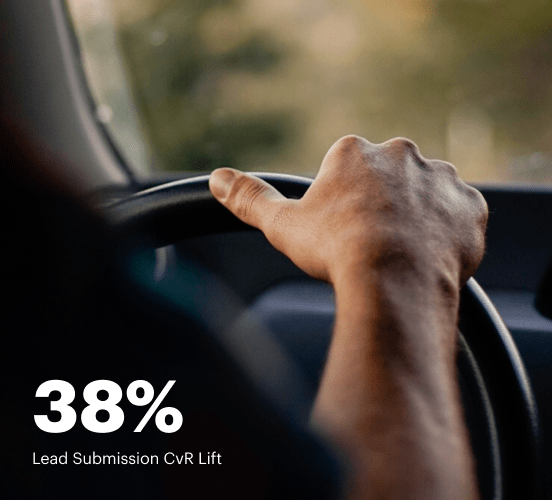How Webflow vs. Microsoft Forms vs. Instapage stack up against each other
Compare Instapage with Webflow and Microsoft Forms to create high-converting landing pages. With personalization, optimization, and collaboration tools, Instapage helps you deliver experiences that drive results.
Get startedSee how Instapage stacks up against the competition
| Feature | Instapage | Other builders |
| Drag-and-Drop Tools | ||
| Conversion-optimized templates | ||
| Manual and AI-powered A/B Tests | ||
| AI content suggestions | ||
| Popups and sticky bars | ||
| Canvas and grid blocks | ||
| Reusable and global elements | ||
| Form and popup builders | ||
| Built-in Heatmaps | ||
| Central analytics dashboard | ||
| Ad-to-page personalization and collections | ||
| Contacts, lists, and email | ||
| Dedicated, full-service CRO experts | ||
| Enterprise-ready platform |
Leading the way in building high-performing landing pages





Why Instapage is the smarter choice for your campaigns
Get everything you need to build, scale, and optimize high-converting landing pages—without coding.

Easier page building without coding
Instapage offers a flexible and seamless page creation experience with a library of 500+ conversion-focused layouts, Instablocks®, a drag-and-drop builder, and AI content generation. With technologies like Thor Render Engine®, you can create on-brand, mobile-responsive landing pages that load quickly and start converting during initial visitor clicks.

More insights — better results
Instapage lets you see in detail how each landing page experience and variation is performing so you can make targeted changes that boost page conversions. Use heatmaps for a better understanding of on-page activities, run A/B tests and AI-assisted experiments, and then track and evaluate results within robust analytics dashboards.

More personalized experiences
Instapage lets you quickly create high-performing landing pages tailored to each of your ad campaigns. Deliver personalized experiences for distinct audiences using dynamic text replacement. Effortlessly align specific advertisements to unique pages with AdMaps. Monitor audience-level metrics using our advanced data tools.

Built-in collaboration
Instapage collaboration capabilities bring your entire team together to speed up the process of landing page review, approval, and launch. No more frustrating and unnecessary revisions or edits scattered across emails. Provide instant feedback, conduct real-time page edits, and securely share your pages with outside stakeholders.

Free up time for your business
Invest time into business growth, not busy work. Launch landing pages faster with reusable forms and templates. Build once, reuse forever.
Explore all integrations






Easier page building without coding
Instapage offers a flexible and seamless page creation experience with a library of 500+ conversion-focused layouts, Instablocks®, a drag-and-drop builder, and AI content generation. With technologies like Thor Render Engine®, you can create on-brand, mobile-responsive landing pages that load quickly and start converting during initial visitor clicks.
More insights — better results
Instapage lets you see in detail how each landing page experience and variation is performing so you can make targeted changes that boost page conversions. Use heatmaps for a better understanding of on-page activities, run A/B tests and AI-assisted experiments, and then track and evaluate results within robust analytics dashboards.
More personalized experiences
Instapage lets you quickly create high-performing landing pages tailored to each of your ad campaigns. Deliver personalized experiences for distinct audiences using dynamic text replacement. Effortlessly align specific advertisements to unique pages with AdMaps. Monitor audience-level metrics using our advanced data tools.
Built-in collaboration
Instapage collaboration capabilities bring your entire team together to speed up the process of landing page review, approval, and launch. No more frustrating and unnecessary revisions or edits scattered across emails. Provide instant feedback, conduct real-time page edits, and securely share your pages with outside stakeholders.
Free up time for your business
Invest time into business growth, not busy work. Launch landing pages faster with reusable forms and templates. Build once, reuse forever.
Explore all integrationsGet started with Instapage in a few steps
-
Create your Instapage account
Start with Instapage by signing up via Google or your email. You'll get access to a free 14-day trial to discover Instapage capabilities. Feel free to cancel anytime during the 14-day trial if you decide that our product is not suitable for your business. -
Build and personalize your page
Create your first landing page from scratch or choose a template from 500+ customizable layouts. Use the drag-and-drop builder to add page elements, fonts, and backgrounds, refine content with AI, or add custom HTML, Javascript, and CSS. -
Review and make edits
Collaborate on page designs and streamline review processes. Invite your team members and stakeholders to review, edit, and provide feedback on your landing page. Collaborate knowing your page is confidential and only accessible to authorized users. -
Publish and track page performance
Publish your page to a domain or custom URL. Connect your pages to the ads you've created and track page performance within the analytics dashboard, run A/B tests and AI experiments, analyze results, and continuously optimize your landing page to maintain high conversions.
Instapage vs. Webflow vs. Microsoft Forms – The Ultimate Showdown!
Choosing a landing page builder can feel like assembling an all-star team for a big game, with each contender bringing unique skills to the table. Instapage, Webflow, and Microsoft Forms are like the superstar players of digital marketing, each with their distinctive strengths that can enhance your marketing strategy. Imagine Instapage as the skilled forward, adept at scoring conversions with precise landing pages; Webflow as the versatile midfielder, blending stunning design with functionality; and Microsoft Forms as the reliable defender, ready to gather insights with form-building prowess. Throughout this article, we will engage in a friendly competition among these platforms, analyzing their capabilities and helping you determine which one is right for your needs. Whether you’re looking to reduce costs, enhance your conversion rates, or create tailored landing page experiences that foster brand trust and loyalty, this comparison will shed light on the best option for you. Get ready for an exciting ride through the features, speed, usability, and pricing of these three contenders!
Meet the Contenders: A Brief Overview
Let’s welcome our three educators in the realm of landing page creation: Instapage, Webflow, and Microsoft Forms! Each of them shines in their domain, attracting marketers with various requirements. Instapage has earned a stellar reputation for its capabilities in creating high-converting landing pages, enabling marketers to reduce costs and grow conversions seamlessly. With its focus on delivering relevant landing page experiences, Instapage helps build brand trust and enhances customer loyalty. Meanwhile, Webflow is celebrated for its powerful design capabilities, allowing businesses to build responsive websites without frustrating coding issues. By providing a blend of design and functionality, Webflow caters to creative individuals aiming for visually appealing results. On the other hand, Microsoft Forms stands out as a simple and effective way to gather data and insights, making it a choice for those wanting to easily create forms and surveys. In this battle for landing page excellence, all contenders have unique features that cater to different audiences. Let’s explore their strengths and weaknesses as we dig deeper!
Feature Face-off: Who Has the Upper Hand?
Template Variety and Ease of Use: A Comparison
When it comes to template variety and ease of use, each platform comes with its own benefits. Instapage offers an impressive library of customizable templates designed specifically for creating landing pages that convert. Users can start with a wide range of pre-built options and fine-tune them to match their branding, making it accessible for both beginners and experienced marketers. In contrast, Webflow excels in offering more sophisticated design templates, but may require a steeper learning curve due to its complex functionalities. For those new to digital design, the array of choices can feel overwhelming. Meanwhile, Microsoft Forms focuses on simplicity, providing a user-friendly interface that allows anyone to create surveys or forms quickly. With limited template options, its strength lies in customization for question types rather than visual aesthetics. Each platform, therefore, has exciting features, catering to different user skills and preferences. This round showcases that Instapage’s focus on ready-to-use templates makes it a winner in fast and efficient landing page creation.
Instapage: Customization and Conversion Optimization Galore
Instapage not only stands out with its remarkable selection of landing page templates, but it also champions unmatched customization options that elevate user experiences. The platform empowers marketers to adapt or build landing pages that align perfectly with their campaign goals. This ability to seamlessly optimize landing pages creates an environment ripe for increased conversions. Users can employ A/B testing tools to discover which elements resonate best with their audience, ensuring efforts lead to tangible results. With built-in analytics, Instapage presents insights that help marketers fine-tune their strategies, ultimately enhancing ROI. The emphasis on conversion rate optimization combined with user-friendly design makes Instapage a true partner in marketing success, paving the way for better brand reputation and customer loyalty. In the realm of landing page builders, those looking to elevate their campaigns through robust features will find Instapage consistently delivers.
The Speed Test: Performance Evaluation
Picture this: you're eagerly waiting for your favorite show to buffer. Frustrating, isn’t it? Pages that load slowly can kindle the same annoyance in potential customers, causing them to lose interest and abandon their journey. For our landing page builders, speed and performance become critical factors in ensuring user engagement and satisfaction. To illustrate, Instapage optimizes loading times by enabling users to create lightweight landing pages designed for speed. Pages designed on the platform often load in under three seconds, helping keep bounce rates low and conversions high. Similarly, Webflow configurations offer fast-loading capabilities but depend significantly on the amount of content and design elements used. Lastly, Microsoft Forms keeps things straightforward and speedy, ensuring form loading times remain minimal. As user experience plays a crucial role in engagement, speed considerations underline Instapage’s pivotal advantage over the others.
Instapage Advantages:
- Optimizes loading times for swift page access.
- Lightweight design ensures minimal bounce rates.
- Built-in A/B testing helps refine user experience.
- Offers insights through analytics for better decision-making
Webflow Advantages:
- Customization options allow for detailed design control.
- Responsive design ensures smooth performance across devices.
- Integrated animations enhance visual appeal.
Microsoft Forms Advantages:
- User-friendly interface for quick form creation.
- Minimal loading times for a seamless experience.
- Simple survey and polling capabilities.
In conclusion, Instapage takes the crown with its superior loading speeds and performance tailored to landing pages. By placing emphasis on user experience, it emerges as the clear preference for marketers aiming for effective conversion rates, ultimately fostering customer satisfaction and retention.
Usability and Learning Curve: Easing Your Journey
Navigating new software can often feel daunting, yet all three platforms strive to create welcoming environments for users. Instapage’s interface is designed for motivation, encouraging users with clear navigation and intuitive features. The onboarding process ensures that newcomers swiftly gain confidence, enabling them to jump straight into crafting landing pages without losing their spark. Similarly, Webflow’s rich resources, including tutorials and community support, allow designers to climb the learning curve at their own pace, despite its initially complex setup. Meanwhile, Microsoft Forms eases users into form building with its straightforward interface and minimal technical knowledge requirements. Users soon become proficient in crafting engaging forms. This friendly competition reveals that while all platforms are committed to user-centric design, Instapage’s seamless navigation and support certainly make it a top contender for ease of use.
Support Squad: As You Navigate
Consider the customer support teams of each platform as tirelessly dedicated sidekicks available to swoop in with assistance whenever needed. Instapage stands out with a robust support system, offering 24/7 customer service through chat and email, alongside an extensive library of tutorials and guides. This ensures users always have the resources to boost their efficiency. Webflow, while offering support via chat, focuses heavily on empowering users through its community forums, encouraging knowledge-sharing among users. Microsoft Forms also provides excellent customer service through their help center but lacks the extensive features of its competitors. Each platform demonstrates a commitment to providing resources tailored to user needs; however, Instapage’s combination of immediate support and extensive documentation remains unmatched.
Pricing Structures: Which One Fits Your Budget?
When it comes to pricing, it’s essential to balance costs versus features. Instapage operates on a subscription model, allowing users to choose plans that suit their budgets while receiving ample features catered to landing page design and performance. Comparatively, Webflow offers a free tier, but advanced features come at a premium price, making it a potentially costly option for those not requiring an intricate design framework. Microsoft Forms operates within the Microsoft 365 ecosystem, making it more affordable for businesses already utilizing these integrations, but the limitation on design elements may deter those looking for robust landing pages. Analyzing cost structures reveals that Instapage often provides the greatest value considering base subscriptions include advanced features for performance-driven marketing.
In conclusion, while all three platforms showcase their strengths, the best choice ultimately hinges on individual needs and goals. If reducing costs while escalating conversions resonates with you, Instapage deserves a red-carpet welcome. Alternatively, if you're drawn to advanced design capabilities, consider exploring Webflow. For simply gathering insights through forms, Microsoft Forms might be your go-to. Take time to weigh your priorities and embark on this exciting journey with Instapage's free trial or demo. Discover the possibilities today!










